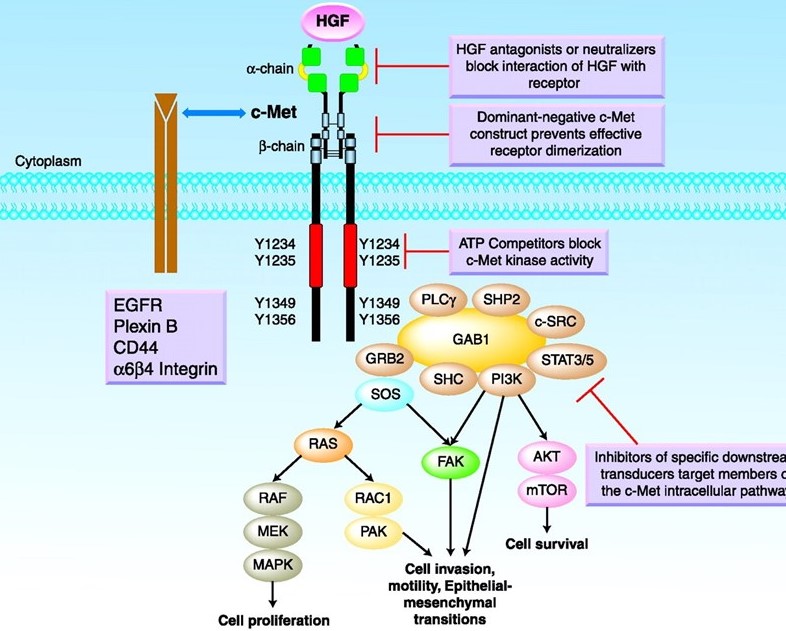c-MET Assay Portfolio Service
c-MET
Cellular-mesenchymal epithelial transition factor (c-Met) is a multifunctional transmembrane tyrosine kinase and acts as a receptor for hepatocyte growth factor/scatter factor (HGF/SF). c-Met, the receptor tyrosine kinases oncogene, was first cloned in 1984. c-Met is produced as a single-chain precursor which is cleavaged by proteolytic to form a mature c-Met composed of a small alpha and large beta polypeptide. A disulfide bridge connects the α unit and β subunit to form a heterodimer. The intracellular β subunit consists of three portions: a SEMA domain, the PSI domain and four IPT domains which are responsible for binding HGF. The intracellular α unit is composed of three portions: a juxtamembrane domain, a tyrosine kinase domain and the C-terminal region. High-affinity binding occurs between the hairpin loop and first Kringle domain of the α-chain of HGF and the third and fourth IPT domain of c-Met. Low-affinity binding occurs between the β-chain of HGF and the sema domain of c-Met. c-Met is expressed in various epithelial tissues during embryogenesis and is also found on the cell surface of many tumors.
HGF/c-MET Signaling Pathway
HGF binding c-Met activates signaling pathways. Activated c-MET binds adaptor molecules GRB-1 and GRB-2, and then they recruit Ras/Raf, SH2 containing protein tyrosine phosphatase (SHP2), STAT3/5 and PI3K signals. In addition, activation of other receptor tyrosine kinases (RTKs) signaling molecules (HER2, VEGFR, EGFR and ALK) may cross-talk with the c-MET, further recruiting PI3K, ERK and STAT3/5 signals. These downstream signals are involved in regulating cell morphogenesis, survival, proliferation, transformation, motility and invasion.
 Fig.1 c-MET signaling pathway. (Eder, 2009)
Fig.1 c-MET signaling pathway. (Eder, 2009)
The Function of c-MET in Cancers
HGF/c-MET signaling is involved in various human malignancies. There are three biological mechanisms underlying the tumorigenicity of c-MET: a) the formation of HGF/c-MET autocrine loop; b) the overexpression of HGF or c-MET; and c) activation of mutations in the c-MET receptor. The activation of c-MET signaling triggers a diverse series of signaling cascades that can cause tumor cell growth, proliferation, protection from apoptosis, angiogenesis, cell dissociation and motility and invasion. For example, c-MET is overexpressed in numerous cancers, such as gastric cancer line, thyroid carcinomas, colorectal cancer and many other epithelial tumors. Both germline and somatic mutations in c-Met have been reported in a wide variety of cancers. These mutations increase oncogenic potential via constitutive activation of the c-Met receptor. c-MET mutation occurs at a low frequency but provides strong evidence of the pathway’s tumorigenic potential.
What Can We Offer?
Extensive evidence that c-Met signaling is involved in the progression and spread of several human cancers. Understanding the integration between the HGF/c-Met axis and other oncogenic signaling pathways may lead to stronger treatment modalities soon. Creative Biolabs offers a full set of c-MET assay portfolio services, including cell proliferation assay, cell survival assay, in vitro killing assay, cell migration and invasion assay, cell adhesion assay, cell apoptosis assay, tube formation assay, western blot analyses, Immunofluorescence, immunohistochemistry and so on.
Creative Biolabs provides a wide variety of tumor marker assay services to meet our customers’ requirements. With our professional and efficient services, we can help you sincerely to advance your project successfully. We have multiple new products and services in the pipeline and the capacity to add more where warranted. Please feel free to contact us for more information.
Reference
-
Eder, J.P.; et al. Novel therapeutic inhibitors of the c-Met signaling pathway in cancer. Clin Cancer Res. 2009, 15(7): 2207-2214.
For Research Use Only | Not For Clinical Use


 Fig.1 c-MET signaling pathway. (Eder, 2009)
Fig.1 c-MET signaling pathway. (Eder, 2009)
 Download our brochure
Download our brochure